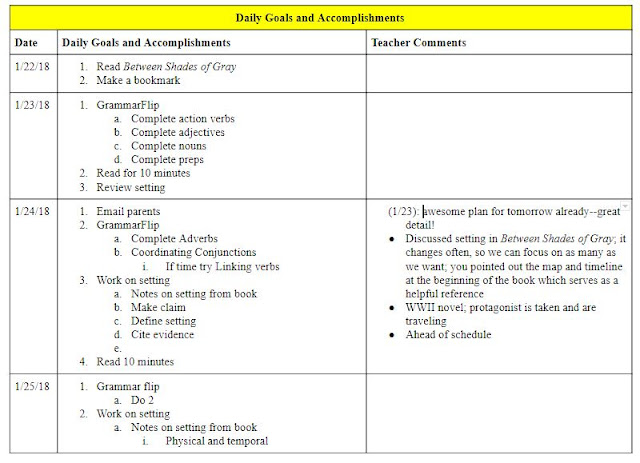Weekly Student-Authored E-mails Home on Progress
Inspired by a blog
by Catlin Tucker (@catlin_tucker), I decided to have my students e-mail home
every week. Catlin explained how she has students e-mail parents when they fall
behind. Since I was shifting to a workshop model, I thought this activity would
help include families more as well as keep students engaged with our learning
activities. Also, the use of daily work logs ensures we have a record of what
we have been doing in class so we have something specific to report on each
week.
I have done one of these e-mails home so
far, but I thought I’d share my early process here.
Daily
Work Logs
As part of our workshop model, I began
including a Daily Work Log via Google, where each student lists the assignments
and work he or she must complete each day. These work logs become a great resource
for the weekly e-mails. This is a process to teach students goal-setting and
subdividing larger tasks into smaller pieces (even if they can accomplish multiple
pieces in one day during class. Our work log has our daily goals (I have been
giving suggestions on what to include here at the start of the semester), and
then further down in the document are our learning targets for the unit. I may
leave comments in their log or next to a specific target. Here are some
examples:
Full disclosure: I have not gotten to
every student this past week, so not every student has feedback from me. Please
do not think this process is magical and working 100% yet! Budgeting time to
reach every student and balancing how much written feedback to leave in their
daily logs is a task I am still refining—of course, sometimes there is a quick
question I answer, or my mini-lesson answers their concerns.
Weekly
E-mails Home
When students have their syllabus signed,
we ask for parent e-mail addresses (or if not, we can use Remind or print the
letter and have the student take it home to be signed). Parents do not need to
respond to this e-mail, but some have with words of encouragement to their
students.
Students then use their Daily Logs to
review what they have accomplished and summarize their work. In future weeks,
they will be able to refer back to my comments and feedback (and scores on
assessments) to add specificity.
Students are to write the letter in
Google, copy it into an e-mail, address it to their parent(s), CC me (and any IEP
or GIEP casemanager), and title it “Last Name, Weekly English Update Month/Day”
(ex: Emmanuele, Weekly English Update 1/24).
I tried to look over everyone’s before
they hit “send,” but since I am CC’d, I can follow up later if need be. As we
move ahead, I will know the students I need to talk with (if they are missing
assignments that they should explain to parents, etc.)
Here is the template I provided for my
students on Google:
I was excited to see parent responses of encouragement.
I told each of my classes that if they normally communicate with parents in a
language other than English that we can type in another language (if the
student can write in a home language, as I was unsure if I could trust Google
translate). One student speaks Korean at home, so he used his phone to type in
Korean; he typed it in English and Korean. It’s a little more work for him, but
I was excited to see him engage with this process to best communicate with home
(and I am trusting his honesty—but since the English is also included, I know
he at least is reflecting on his work).
Moving
Ahead
This process so far is very exciting. The
weekly e-mails may become more complicated as we begin balancing more
assignments and work during workshop, but since we have workshop time, I am
dedicating every Wednesday to this home communication to better include parents
and encourage students to reflect on their work and plan ahead.
Now, since we have completed one week of
e-mails and parents have received them, I am committed—this is not an
initiative I can now dissolve, since we’ve already begun!









Awesome idea! I will totally incorporate this into the new semester. This simple activity allows for some student reflection and it keeps parents up-to-date in the classroom!
ReplyDelete